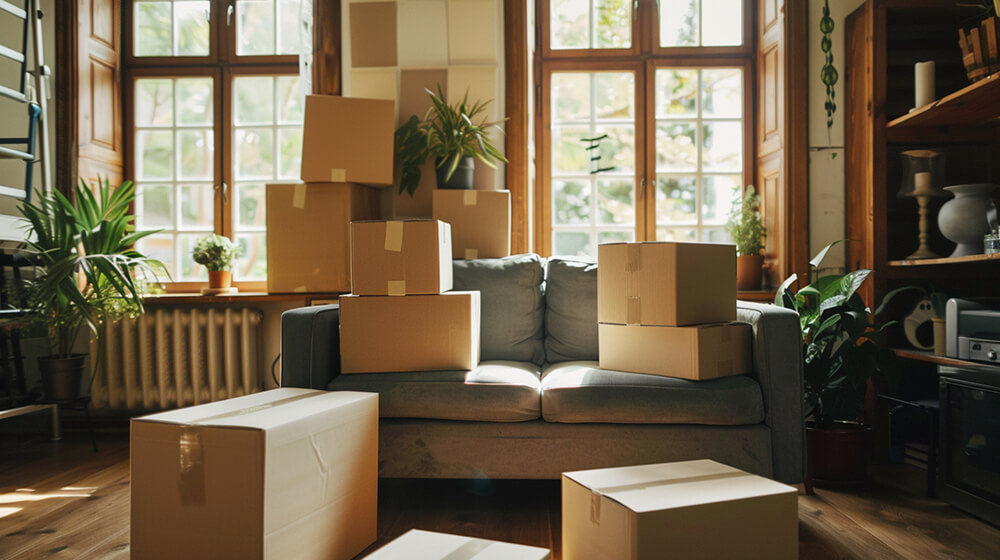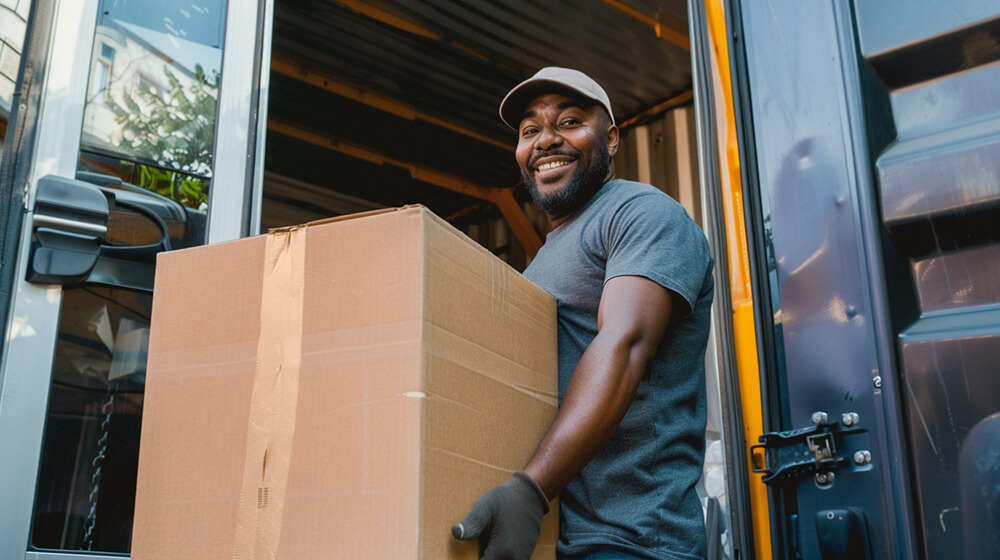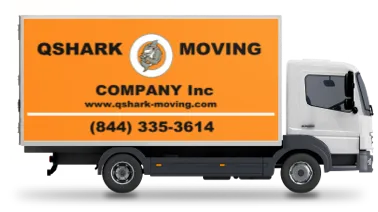
Moving to a new home is an exciting yet challenging experience. One crucial step to make your move smoother and more efficient is decluttering. By sorting through your belongings and getting rid of items you no longer need, you can significantly reduce the stress and chaos associated with moving. Decluttering not only lightens your load but also helps you start fresh in your new space.
Qshark Moving understands the importance of a streamlined moving process. As a leading moving company in California, Qshark Moving offers professional services to ensure your transition is as seamless as possible. Our experienced team can help you not only with the physical aspects of moving but also with expert advice on decluttering and organizing your belongings before the big day.
Why Decluttering Before a Move is Essential
Decluttering before a move is more than just a way to tidy up. It plays a critical role in making your move more cost-effective, efficient, and stress-free.
Reduce Moving Costs
One of the primary benefits of decluttering is cost reduction. The fewer items you have to move, the lower your moving expenses will be. Moving companies often charge based on the weight and volume of your belongings, so by eliminating unnecessary items, you can significantly cut down on costs.
Simplify Packing and Unpacking
Decluttering makes packing more manageable and unpacking less overwhelming. When you sort through your belongings beforehand, you can organize and pack them more systematically. This organization translates into an easier unpacking process, allowing you to settle into your new home more quickly and efficiently.
Create a Fresh Start
Moving to a new home offers the perfect opportunity for a fresh start. Decluttering helps you let go of items that no longer serve you, making space for new experiences and memories in your new environment. A decluttered home is not only more aesthetically pleasing but also promotes a sense of calm and order, which is especially important during the often chaotic moving process.
Planning Your Decluttering Process

A well-thought-out plan is essential for effective decluttering. Here’s how to get started:
- Set a Decluttering Timeline: Begin by setting a timeline for your decluttering process based on your moving date. Ideally, start decluttering at least a month before your move. This gives you ample time to go through your belongings without feeling rushed.
- Allocate Specific Days and Times: Schedule specific days and times for decluttering tasks. Consistency is key to avoiding last-minute stress. Whether it’s dedicating an hour each day or setting aside weekends, having a clear schedule helps keep you on track.
- Create a Checklist: A checklist can be incredibly helpful in organizing your decluttering process. List all the areas and items that need to be sorted through, such as closets, kitchen cabinets, and garage spaces. Breaking down the task into smaller, manageable chunks makes the process less daunting and more achievable.
Decluttering Methods: Location vs. Category
Choosing the right decluttering method can make a significant difference in how effectively you can sort through your items. Here are two popular approaches:
Decluttering by Location
This method involves tackling one room or area at a time. For example, you might start with the kitchen, move on to the living room, and then handle the bedrooms. This room-by-room strategy allows you to see progress in specific areas, making the process feel more manageable.
Decluttering by Category
Alternatively, you can declutter by category, such as clothing, books, or kitchenware. This involves gathering all items of a specific category from different parts of your home and sorting them together. This method helps you see the full extent of what you own in each category, making it easier to identify duplicates and unnecessary items.
Pros and Cons of Each Method
Decluttering by location can be less overwhelming since you focus on one area at a time. However, it may lead to repeatedly encountering the same types of items. Decluttering by category provides a comprehensive view of your belongings but can be more chaotic as it requires moving items around the house.
Step-by-Step Decluttering Guide
Start Early
The sooner you start decluttering, the smoother your move will be. As soon as you know you’re moving, begin sorting through your belongings. This will give you ample time to thoughtfully go through each item without feeling rushed or overwhelmed.
Gather Supplies
Before diving into decluttering, gather all necessary supplies. You will need:
- Boxes: Various sizes for packing different items
- Trash Bags: For items that need to be discarded
- Donation Bins: For items you plan to give away
- Labels and Markers: To keep everything organized
Having these supplies on hand will make the process more efficient and help you stay organized.
Sort Items
Create a sorting system to categorize your belongings into five groups:
- Keep Items you will take with you to your new home.
- Donate Items in good condition that can be donated.
- Sell Valuable items that you can sell.
- Recycle Items that can be recycled rather than trashed.
- Trash Items that are broken, outdated, or no longer usable.
Room-by-Room Breakdown
To keep the process manageable, declutter room by room. Here’s a breakdown of what to focus on in each area:
Kitchen:
- Discard expired food and spices
- Donate or sell small appliances you rarely use
- Recycle old plastic containers and utensils
Living Room:
- Sort through books, DVDs, and magazines
- Donate or sell unused decor
- Evaluate furniture and decide what fits in your new space
Bedrooms:
- Go through clothing and donate items you haven’t worn in a year
- Sort through shoes, accessories, and seasonal items
- Clear out nightstands and dressers
Bathrooms:
- Dispose of expired medications and beauty products
- Donate unopened toiletries
- Organize remaining items in bins or baskets
Garage:
- Discard broken tools and equipment
- Donate sports gear and outdoor items you no longer use
- Sort through holiday decorations and storage items.
Basic Tips for Efficient Decluttering

Use the 20/20 Rule
The 20/20 rule can help you make quick decisions about items you’re hesitant to let go of. If you can replace an item for less than $20 and in under 20 minutes, it’s safe to discard it. This rule helps minimize the “just in case” mentality that leads to clutter.
Ask Critical Questions
When deciding whether to keep an item, ask yourself:
- Do I use this regularly?
- Does it serve a purpose in my life?
- Does it hold significant sentimental value? These questions help you focus on what’s truly important and eliminate unnecessary items.
Use a Three-Box System
A three-box system is an effective way to organize your decluttering efforts:
- Keep Box: For items you will move with you.
- Donate Box: For items in good condition that others can use.
- Discard Box: For items that are no longer useful or needed. This system keeps you organized and ensures you’re making progress.
Handling Special Categories
Certain categories of belongings require special attention during the decluttering and moving process. Items like clothing, furniture, paperwork, and food each have unique considerations to ensure they are properly sorted and managed.
In this section, we’ll provide detailed advice on handling these specific categories, from organizing seasonal clothing and measuring furniture for your new space to digitizing important documents and minimizing food waste. These tailored strategies will help you efficiently manage your belongings and make your move as seamless as possible.
Clothing
When decluttering clothing, focus on:
- Seasonal Items: Pack away off-season clothing.
- Rarely Worn Clothes: Donate items you haven’t worn in a year.
- Sentimental Pieces: Keep only those with significant sentimental value.
Furniture
Measure your new space to ensure your furniture fits. Donate or sell items that won’t fit or that you no longer need. This reduces moving costs and helps create a functional layout in your new home.
Paperwork
Organize and digitize important documents to reduce paper clutter. Shred and recycle outdated or unnecessary paperwork. Use folders and labeled boxes for essential documents you need to keep physical copies of.
Food
Check expiration dates and minimize food waste. Plan meals to use up what you have, and donate non-perishable items that you won’t consume before the move. This helps reduce the load and ensures you start fresh in your new kitchen.
Donation and Disposal Tips
Decluttering often results in a pile of items you no longer need or want. Knowing how to properly donate and dispose of these items is crucial to minimizing waste and helping those in need.
This section offers practical tips for identifying local donation centers, scheduling donation pickups, and recycling electronics and hazardous materials responsibly. By following these guidelines, you can ensure that your unwanted items are handled in an environmentally friendly and community-beneficial manner.
Identify Local Donation Centers
Research local donation centers and understand their requirements. Many organizations will accept gently used clothing, furniture, and household items. Some may even offer pickup services for large donations.
Schedule Donation Pickups
For large items or bulk donations, schedule pickups in advance. This ensures your donations are collected on time, and you’re not left with unwanted items on moving day.
Properly Recycle Electronics and Hazardous Materials
Dispose of electronics and hazardous materials responsibly. Look for local e-waste recycling programs or hazardous waste disposal events. This ensures these items are handled properly and don’t harm the environment.
Packing After Decluttering
After you’ve decluttered your home, the next crucial step is packing your belongings efficiently. Proper organization during packing ensures that your move is smooth and your items arrive safely at your new home.
In this section, we’ll provide essential tips for organizing your packed boxes, labeling them effectively, and preparing a necessity box for those first critical days in your new place. With these strategies, you can streamline your move and reduce the stress of settling into a new environment.
Tips for Organizing Packed Boxes
Once you’ve decluttered, it’s time to start packing efficiently. Begin by grouping similar items together and packing them into appropriately sized boxes. Use smaller boxes for heavier items like books and larger boxes for lighter items like linens. Fill any gaps with packing paper or bubble wrap to prevent items from shifting during transit (The Homes I Have Made) (Declutter in Minutes).
Labeling Boxes by Room and Content
Label each box with its destination room and a brief description of its contents. This will make the unpacking process much smoother, allowing you to prioritize which boxes to open first. Consider using color-coded labels or stickers to easily identify boxes at a glance (PODS) (Minimalism).
Preparing a Necessity Box for the First Days in the New Home
Pack a necessity box with items you’ll need immediately upon arrival at your new home. Include essentials like toiletries, a change of clothes, basic kitchen supplies, important documents, and any other items you’ll need to have on hand during the first few days. This box should be clearly marked and kept easily accessible (The Homes I Have Made) (SEKA Moving & Storage).
Using Professional Help and Storage Solutions
Benefits of Hiring Professional Organizers
Hiring a professional organizer can be incredibly beneficial, especially if you’re overwhelmed by the amount of stuff you need to sort through. Professional organizers can provide expert advice, help you make tough decisions, and create a systematic plan for decluttering and packing.
Temporary Storage Options Like Portable Storage Containers
If you need temporary storage for items you can’t decide on or want to move in stages, consider using portable storage containers. These containers can be delivered to your home, filled at your convenience, and then stored at a secure facility or transported to your new location. This flexibility can make the moving process less stressful and more organized.
Reach Out to Qshark Moving for Comprehensive Moving Services
For a truly hassle-free move, consider contacting Qshark Moving. Our comprehensive moving services include everything from packing and transportation to storage solutions. With the professional help of our seasoned moving team, you can focus on settling into your new home while they handle the logistics of your move.
The Bottom Line
Decluttering before a move offers numerous benefits, including reducing moving costs, simplifying the packing and unpacking process, and providing a fresh start in your new home. By starting early, using efficient decluttering methods, and enlisting professional help when needed, you can ensure a smoother transition to your new space.


 How to Pack Artwork for Moving
How to Pack Artwork for Moving How to Move a Pool Table
How to Move a Pool Table What to Get Rid of When Moving
What to Get Rid of When Moving How to Pack a TV for Moving
How to Pack a TV for Moving How to Label Moving Boxes
How to Label Moving Boxes